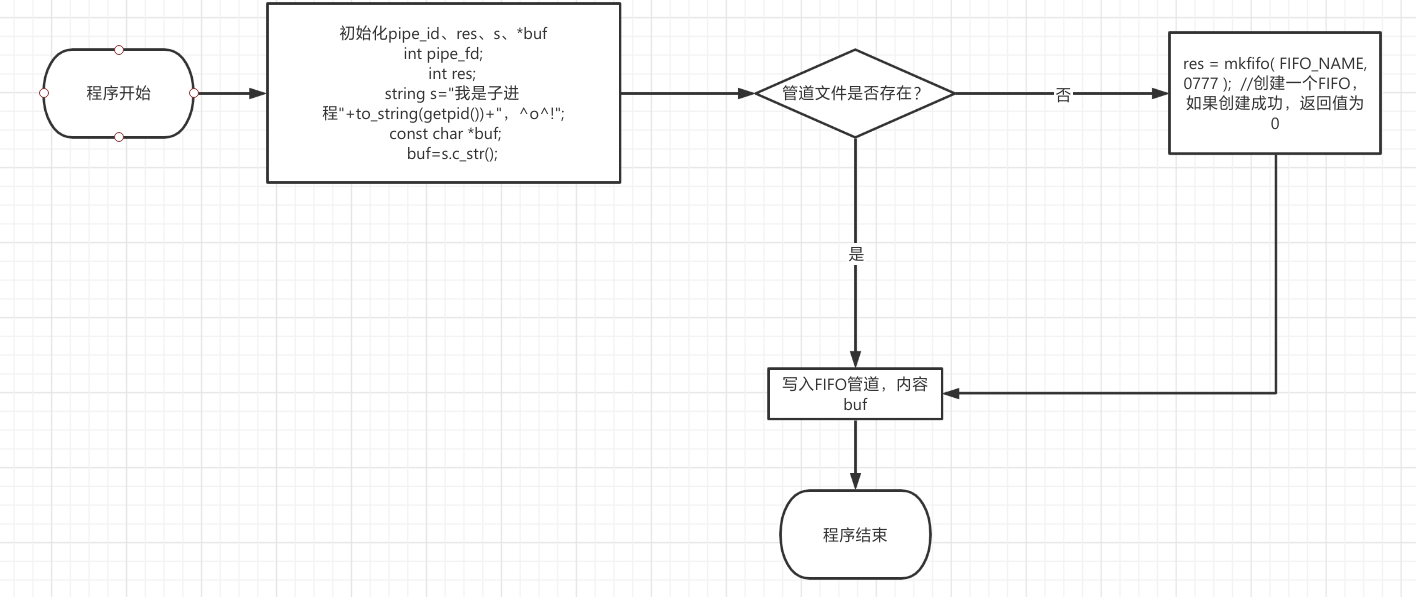
操作系统——使用FIFO函数进行通信,由进程A生产数据,由进程B读取数据。(包含程序框图)
操作系统——使用FIFO函数进行通信,由进程A生产数据,由进程B读取数据。(包含程序框图)
实验结果
Linux效果图(采用UOS + VScode + g++)

程序框图(生产数据)

程序框图(读取数据)

C++代码(生产数据):
/*生产数据*/
#include <iostream>
#include<cstring>
#include <unistd.h>
#include <string.h>
#include <fcntl.h>
#include <sys/types.h>
#include <sys/stat.h>
#define FIFO_NAME "/tmp/my_fifo"
using namespace std;
int main() {
int pipe_fd;
int res;
string s="我是子进程"+to_string(getpid())+",^o^!";
const char *buf;
buf=s.c_str();
//如果管道文件不存在,就创建
if(access(FIFO_NAME, F_OK)==-1) {
res = mkfifo( FIFO_NAME, 0777 );
//创建一个FIFO,如果创建成功,返回值为0
if(res!=0) {
cout<<"没能成功创建FIFO:"<<FIFO_NAME<<endl;
exit( EXIT_FAILURE );
//表示异常退出
}
}
cout<<"进程:"<<getpid()<<" 打开FIFO管道:"<<FIFO_NAME<<endl;
pipe_fd = open( FIFO_NAME, O_WRONLY );
//以只写方式打开
if(pipe_fd==-1 ) {
cout<<"打开失败\n";
exit( EXIT_FAILURE );
//打开失败,异常退出
} else {
res=write( pipe_fd, buf, 30 );
if(res==-1 ) {
cout<<"写失败\n";
exit( EXIT_FAILURE );
}
close( pipe_fd );
}
cout<<"进程:"<<getpid()<<" 写结束 写入的内容为:"<<buf<<endl;
exit( EXIT_SUCCESS );
//成功退出
}
//g++ test52.cpp -o test52&&./test52
C++代码(读取数据):
/*读取数据*/
#include <iostream>
#include <unistd.h>
#include <string.h>
#include <fcntl.h>
#include <sys/types.h>
#include <sys/stat.h>
#define FIFO_NAME "/tmp/my_fifo"
using namespace std;
int main() {
int pipe_fd;
int res;
char buf[30];
cout<<"进程:"<<getpid()<<" 打开FIFO管道:"<<FIFO_NAME<<endl;
pipe_fd = open( FIFO_NAME,O_RDONLY );
//以只读方式打开
if(pipe_fd==-1) {
cout<<"打开失败\n";
exit( EXIT_FAILURE );
//异常退出
} else {
res = read( pipe_fd, buf, 30);
if( -1 == res ) {
cout<<"读失败\n";
exit( EXIT_FAILURE );
//异常退出
}
close( pipe_fd );
}
cout<<"进程:"<<getpid()<<" 读结束 读出的内容为:"<<buf<<endl;
exit( EXIT_SUCCESS );
//成功退出
}
//g++ test521.cpp -o test521&&./test521





 浙公网安备 33010602011771号
浙公网安备 33010602011771号